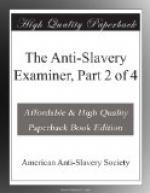In 1832, the crop rose to 91,000 hogsheads of sugar,
and nearly twenty millions of pounds of coffee.
But 1833 comes, and, with it, fresh troubles for the
planters. In that ill-fated year, there was a
decrease of 13,000 hogsheads sugar, and of ten millions
of pounds of coffee. Its sugar crop was the smallest
made, with the exception of that of 1825, since 1793,
and its coffee crop since that of 1798. But if
this determination be alarming, what must be that of
the succeeding years. Can we be blamed, if, in
a strain truly lachrymal, we allude to the deductions
which have annually been made from the miserable return
which 1833 gave to the unfortunate proprietors of
estates? What boots it to tell us that we have
fingered thousands of pounds sterling, in the shape
of compensation: and what consolation is it to
know, that a hogshead of sugar will now bring thirty
pounds, which, a short time ago, was only worth twelve.
Let any
unprejudiced individual look at the
return now before us, and say whether our prospects
are not deplorably dull and obscure. If we take
the four years immediately preceding the passing of
Mr. Canning’s resolutions, say 1819, 20, 21,
and 22; we will find the average to be 105,858 hogsheads,
and if from this we even deduct one fourth for the
time now lost, there will be an average crop of 79,394
hhds., being 7,185 hogsheads mere than the average
of 1833, 34, 35, and 36; and no one will deny that
this falling off of one tenth, (supposing that the
hogsheads made during the last four years are
not
larger than those of 1819 to 1822) is
nearly,
if not
quite equal to the increase of price,
from twelve to thirty pounds, or one hundred and fifty
per cent.
It is true some persons may be disposed to take the
four years subsequent to the passing of Mr. Canning’s
resolutions, say 1823, 4, 5, and 6, and compare them
with the four years ending 31st December last.
Should this be done, it will be found that the average
crop of the previous four years is 91,980 hhds., and
if from it is deducted one fourth, there will remain
68,985 hhds., whilst the average of the other four
years is 72,200 hhds. Such a mode of comparison
must, however, be obviously incorrect; because, in
the first place, Mr. Canning’s resolutions had
reduced the crops of those years considerably below
the average of the years immediately preceding them,
and next, because it would show the advantage to be
on the side of freedom in the ratio of seventy-two
to sixty-nine, which cannot be correct. Besides,
in 1824, there was a severe drought, whereas in 1834
and 35 the seasons are reported as being favorable.
Again, it is necessary, in instituting such an inquiry,
to go back more than fourteen years; nor is it a valid
objection to this to say, that even during that period
a number of estates have been thrown out of cultivation,
in consequence of being worn out and unprofitable.
“Deplorable,” however, as is the “falling
off in the yearly amounts of our staple productions,




